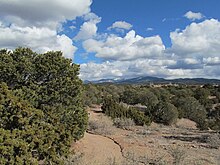Pinyon-juniper woodland

Single-leaf Pinyon-Utah Juniper woodland in northeastern Nevada near Overland Pass at the south end of the Ruby Mountains
Pinyon-juniper woodland, also spelled Piñon-juniper woodland, is a vegetation type (biome) of Western United States higher elevation deserts, characterized by being an open forest dominated by low, bushy, evergreen junipers (Juniperus osteosperma,[1][2]Juniperus californica,[2][3]Juniperus grandis[3]), pinyon pines (Pinus monophylla,[2][3]Pinus edulis[2]), and their associates which vary from region to region.[1][4][5] The woodland's crown height may vary from less than 10 meters up to 15 meters, depending on the site.[6] It may consist of pure stands of pinyon pine, or pure stands of juniper.[3]
Contents
1 Range
1.1 Arizona and New Mexico
1.2 Utah and Canyonlands Region
1.3 Mojave Desert
1.4 Sierra Nevada
2 See also
3 References
3.1 Sources
Range

Range of Pinyon-Juniper Woodlands in the Western United States
The Pinyon-juniper woodland range spans from New Mexico, to the eastern Sierra Nevada, the Colorado Plateau, the Great Basin, and higher elevations of Mountain ranges of the Mojave Desert. [7] The woodland's range includes the Mogollon Rim in the south, to its northern extent in the Snake River Plain.[8]
Arizona and New Mexico

In Santa Fe, New Mexico
The Pinyon-juniper woodland is one of the most prevalent types of coniferous woodland in northern Arizona and New Mexico.[9]
Utah and Canyonlands Region
The pinyon-juniper plant community covers a large portion of Utah and the Canyonlands region.[1] singleleaf ash (Fraxinus anomala), and Utah serviceberry (Amelanchier utahensis) are codominants of pinyon pine and Utah juniper in this region.[1] in this region, the community occurs on rocky soils or jointed bedrock.[1]
Mojave Desert
In the steppes adjoining the Mojave Desert, this vegetation type can be found in areas receiving 12-20 inches of annual precipitation, and between 4,500 and 8,000 feet.[2] Associates include bitterbrush (Purshia glandulosa), Apache plume(Fallugia paradoxa), desert sagebrush (Artemisia tridentata), green ephedra (Ephedra viridis), mountain mahoganies (Cercocarpus spp.), and buckwheats (Eriogonum spp.).[2] In the Mojave, pinyon-juniper woodlands are generally above the Joshua Tree Woodlands vegetation type, and requires more annual precipitation.[2][10]
Sierra Nevada
In the eastern Sierra Nevada, the elevation range is 4,000-5,500 feet in the north, and 5,000 to 8,000 feet in the southern reaches of the range.[3] Pinyon-juniper woodland requires 12-20 inches of annual precipitation, so is generally located above the sagebrush scrub vegetation type, which can survive on an average of 7 inches per year.[3] It is located below the alpine zone.[3] There is often an understory dominated by sagebrush (Artemisia tridentata) and its associates.[3] Co-dominants include Jeffrey Pine (Pinus jeffreyi) and an understory of sagebrush scrub or rabbitbrush scrub (Ericameria spp.).[3]
- Junipers, dominant species:
- Juniperus osteosperma
- Juniperus monosperma
- Juniperus scopulorum
- Juniperus californica
- Pinyon Pine, dominant species:
Pinus edulis (Colorado Pinyon or Two-needle Pinyon)
Pinus monophylla (Single-leaf Pinyon)
See also
- Category:Flora of the Southwestern United States
- Category:Flora of the Great Basin
- Category:Flora of the California desert regions
References
^ abcde Damian Fagan, Canyon Country Wildflowers, p. 3
^ abcdefg Pam MacKay, Mojave Desert Wildflowers, p19-20
^ abcdefghi Karen Wiese, Sierra Nevada Wildflowers, 2013, p. 18
^ Ronald J. Taylor, Sagebrush Country
^ Laird Blackwell, Great Basin Wildflowers, p5-6
^ "[Pinyon-juniper ecosystem]". Digital-Desert: Mojave Desert. Retrieved 1 February 2016..mw-parser-output cite.citation{font-style:inherit}.mw-parser-output q{quotes:"""""""'""'"}.mw-parser-output code.cs1-code{color:inherit;background:inherit;border:inherit;padding:inherit}.mw-parser-output .cs1-lock-free a{background:url("//upload.wikimedia.org/wikipedia/commons/thumb/6/65/Lock-green.svg/9px-Lock-green.svg.png")no-repeat;background-position:right .1em center}.mw-parser-output .cs1-lock-limited a,.mw-parser-output .cs1-lock-registration a{background:url("//upload.wikimedia.org/wikipedia/commons/thumb/d/d6/Lock-gray-alt-2.svg/9px-Lock-gray-alt-2.svg.png")no-repeat;background-position:right .1em center}.mw-parser-output .cs1-lock-subscription a{background:url("//upload.wikimedia.org/wikipedia/commons/thumb/a/aa/Lock-red-alt-2.svg/9px-Lock-red-alt-2.svg.png")no-repeat;background-position:right .1em center}.mw-parser-output .cs1-subscription,.mw-parser-output .cs1-registration{color:#555}.mw-parser-output .cs1-subscription span,.mw-parser-output .cs1-registration span{border-bottom:1px dotted;cursor:help}.mw-parser-output .cs1-hidden-error{display:none;font-size:100%}.mw-parser-output .cs1-visible-error{font-size:100%}.mw-parser-output .cs1-subscription,.mw-parser-output .cs1-registration,.mw-parser-output .cs1-format{font-size:95%}.mw-parser-output .cs1-kern-left,.mw-parser-output .cs1-kern-wl-left{padding-left:0.2em}.mw-parser-output .cs1-kern-right,.mw-parser-output .cs1-kern-wl-right{padding-right:0.2em}
^ "Pinyon-Juniper Woodlands - Introduction & Distribution (U.S. National Park Service)". www.nps.gov. Retrieved 2018-01-26.
^ Cronquist, (1972).
^ Dick-Peddie, (1999) pp. 87.
^ Adrienne Knute, Plants of the East Mojave, p31.
Sources
Dick-Peddie, William A. (1999). New Mexico Vegetation: Past, Present, and Future. University of New Mexico Press. p. 280. ISBN 0-8263-2164-X.
Cronquist, Arthur; Arthur H. Holmgren; Noel H. Holmgren; James L. Reveal; James Reveal; Noel Holmgren (1972). Intermountain Flora - Vascular Plants of the Intermountain West, U.S.A. - Geological and Botanical History of the Region, its Plant Geography and a Glossary. Vol. 1. The New York Botanical Garden Press. p. 270. ISBN 0-89327-300-7.
